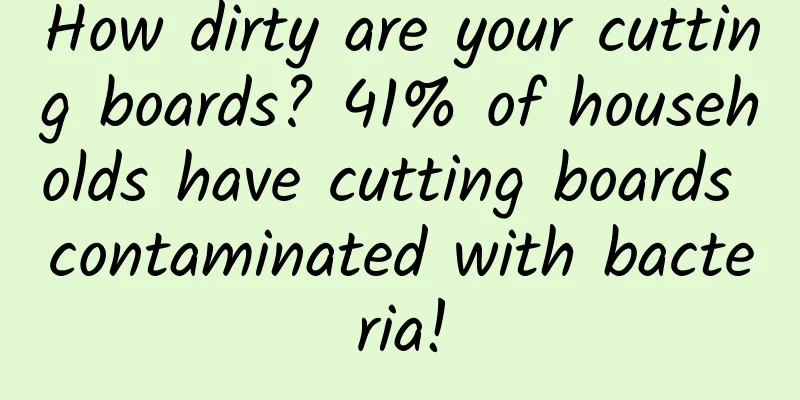How dirty are your cutting boards? 41% of households have cutting boards contaminated with bacteria!

|
Cutting Board A must-have in every kitchen Chopping vegetables and meat is indispensable, but how long do you Didn't change it? Many families have cutting boards with many knife marks, and they have been used for many years without realizing how much harm this will cause to the health of their family. If a cutting board is used for a long time, bacteria will settle and multiply in the knife marks for a long time, and it is difficult for us to remove them. Sometimes when food poisoning occurs, most people only look for problems with the food itself, and few people notice that it may be caused by bacteria on the cutting board. Today we will study: What are the dangers of using a cutting board for a long time? What are the misunderstandings about cutting board disinfection? Which material should I choose for my cutting board? Cutting Board A cutting board that has been used for a long time is really "dirty". The "dirty" here does not refer to the dirt that can be seen by the naked eye, but the microorganisms that are invisible in most cases, especially some harmful bacteria and fungi. The kitchen where the cutting board is placed and used has a high temperature, high humidity, and poor ventilation, which makes it easy for some harmful microorganisms and pathogenic bacteria to grow and multiply. The more and deeper the knife marks on the chopping board, the stronger its "accommodation capacity" for microorganisms , and the greater the probability of the appearance of Escherichia coli, Staphylococcus aureus, Helicobacter pylori, and even aflatoxin, which may cause cancer. If you use a chopping board to mix raw and cooked ingredients, cut raw meat, wash it, and then use it to cut fruit, it is equivalent to eating a lot of raw meat scraps while eating fruit, which can easily cause diarrhea. In addition, some foods rich in protein and fat remain on the chopping board. If they are not cleaned thoroughly, some organic matter will remain , which can easily breed pathogenic microorganisms. A study in 2012 collected samples of dishwashing towels, bowls, cutting boards, etc. from 300 households in Shanghai. When investigating kitchen hygiene conditions, it was found that 41% of the households had cutting boards contaminated with E. coli, and 14% of the households had a serious degree of contamination (>2400MPN/100cm²) . Survey on kitchen hygiene in Shanghai households, source: Health Times At the same time, the study also studied the relationship between the degree of contamination of cutting boards and diarrhea. In general, the more serious the coliform contamination, the more frequent diarrhea occurs . Gastrointestinal diseases such as diarrhea are mainly transmitted through eating, and many foods cannot be separated from the cutting board, so once the cutting board is besieged by harmful microorganisms, the stomach and intestines are the first to be "injured"! Survey on kitchen hygiene in Shanghai households, source: Health Times Misunderstandings about Disinfecting Cutting Boards Some families are reluctant to throw away chopping boards after using them for a long time, and often choose to rinse them with boiling water or brush them with salt. However, these methods are almost useless for disinfecting chopping boards! 1. Rinse with boiling water In order to completely eliminate bacteria and viruses, not only the temperature must be high enough, but also the disinfection time must be long enough. Take the bacteria that cause intestinal infectious diseases and diarrhea, such as Escherichia coli and Shigella dysenteriae, for example. Most of them can only be killed by high temperature of 100℃ for 1 to 3 minutes or heating at 80℃ for 10 minutes . If you just rinse it with boiling water, the temperature will not be high enough and the time will be too short. It will not even remove some heat-resistant pathogens on the surface, let alone the pathogens hidden in the cracks of the cutting board. 2. Brush with salt Sprinkle some salt on the chopping board, brush or wipe it with a sponge or towel dipped in water, and then rinse it with clean water. This is also a way many families disinfect the chopping board. However, this method does not have the effect of disinfection and sterilization. High-concentration salt water can dehydrate some microorganisms and inhibit their reproduction, but it cannot directly kill microorganisms . 3. Sun exposure After washing the cutting board, put it in the sun for a few hours, especially during the afternoon when the ultraviolet rays are the strongest. This can have a certain disinfecting effect, but this method also has some problems: • Long-term exposure to the sun can easily cause deformation of wooden and bamboo cutting boards, especially bamboo cutting boards, which are prone to cracking after being exposed to the sun for a long time. • Depending on the material, some plastic cutting boards are not suitable for exposure to the sun. Not only will they deform, but harmful substances may also escape from them due to high temperatures . 4. Disinfectants such as hydrogen peroxide Hydrogen peroxide, also known as hydrogen peroxide solution, is a strong oxidant. The commonly used disinfection concentration is 2.5%~3.5%, and it has a killing effect on both bacteria and viruses. However, it is not recommended to use it to disinfect tableware, because hydrogen peroxide is mainly used in medicine and industry , is highly corrosive and irritating, harmful to the human body, and may cause cancer. It is generally not used to disinfect tableware. At the same time, it is not recommended to use chlorine-containing disinfectants such as 84 disinfectant to disinfect tableware. Harmful substances in the disinfectant are easy to remain and are also irritating, corrosive and carcinogenic . 5. Effective ways to clean cutting boards Fungi and bacteria are afraid of losing moisture . Therefore, when cleaning and storing cutting boards, you should first choose a ventilated and dry place, and clean and dry them in time after each use. Some fungi, such as aflatoxin, can only be eliminated at a high temperature of over 200 degrees Celsius, and the 100 degrees Celsius used in daily cooking cannot completely eliminate them. Therefore, in addition to normal cleaning with clean water after daily use, you can also choose an appropriate amount of white vinegar and alkaline water (baking soda) for cleaning. The specific steps are as follows: take an appropriate amount of white vinegar or baking soda, add it to water (control the concentration yourself), pour it on the cutting board, clean it with a hard board brush and leave it for a few minutes, then rinse it with clean water and dry it . White vinegar and alkaline water are better than water in cleaning. Experiments show that they can remove about 70% to 80% of the bacteria on the surface, and the operation is simple. In addition, it should be noted that the contact parts of the chopping board standing on the operating table are prone to breeding bacteria, so it is recommended to use the hanging method. Cutting board replacement 1. If these situations occur, the cutting board must be replaced If a cutting board becomes deformed, covered with knife marks, cracked, blackened, or even moldy , it should be replaced. 2. How often should it be changed? Consider the frequency of use and usage habits. If used every day, it is recommended to replace it after 3 months to 1 year. Even if it is not used every day, the maximum period is generally no more than 2 years . 3. Which material should I choose when changing the cutting board? Nowadays, cutting boards are made of many materials, including wood, bamboo, plastic, synthetic, stainless steel, etc. How should we choose? • Wooden cutting board Advantages: Natural materials are relatively healthy; the material is thicker, tougher and stronger, suitable for chopping meat or cutting hard food. Disadvantages: Easy to crack; easy to produce wood chips and knife marks when chopping meat; difficult to clean, strong water absorption, slow air drying, easy to mold and breed bacteria in a humid environment. Key points: You can choose a cutting board made of birch, willow and other materials that are not easy to crack and have no odor . • Bamboo cutting board Advantages: Relatively light texture, natural materials, suitable for cutting vegetables or fruits. Disadvantages: Not as tough as wood, most need to be glued together, and gaps are prone to appear. Key points: Choose products from regular merchants with good pasting technology, and do not buy those with glue or other odors . • Plastic cutting board There are two main types of plastic cutting boards at present, one is PE material and the other is PP material. PE cutting boards are relatively cheaper and can be made into a variety of colors; PP cutting boards are one-piece molded, the price is also more expensive, and only white is available. Advantages: Lightweight, easy to carry, and suitable for cutting fruits and vegetables when going out for a picnic. Disadvantages: easy to deform, not resistant to high temperatures; not suitable for processing foods with high fat content; plastic debris may be harmful to the human body. Key points: The color should be uniform and translucent, with no irritating smell and no powdery feel to the touch . • Synthetic cutting boards Advantages: less water absorption, less residue falling off; food is not easy to slip; some may contain antibacterial ingredients. Disadvantages: more expensive, not suitable for chopping meat. Key points: Choose a regular manufacturer and avoid those with a pungent smell . • Stainless steel cutting board Advantages: Not prone to cracks or mold. Disadvantages: Not as convenient as the previous ones for cutting things, blunt knives, and some inferior stainless steels have an impact on human health after use. Key points: Be sure to choose products from regular manufacturers. |
>>: To prevent complications of diabetes, you need to do these things!
Recommend
Can pregnant women use moxibustion?
In our current lives, many of our friends believe...
What are leukocytes?
There are many cells in our body, and different c...
Can I be pregnant if my period is delayed for a week?
Menstruation is an important indicator of women&#...
Can I sleep on my back when I am four and a half months pregnant?
In daily life, some women will deliberately choos...
Does eating salty food during pregnancy affect the baby?
The dietary structure of pregnant women during pr...
How to prevent buttock pain during confinement
Pregnancy is something that requires extra cautio...
How long does it take for menstruation to come after the first month of confinement?
The short confinement period refers to a situatio...
Are pelvic adhesions serious?
Pelvic adhesion is a type of gynecological diseas...
What does cervical calcification mean?
Uterine calcification generally refers to the app...
How painful is it to remove an IUD that has been there for 20 years?
The IUD removal surgery will also make women feel...
National Nutrition Week | Six steps to eat smartly, eat right and stay healthy
Eating at home is the best opportunity to maintai...
Reasons for sweating under the armpits of women
When we mention armpits, many people immediately ...
What is the best time for women to check for infertility?
Nowadays, due to the pressure of work and surviva...
Will women with kidney deficiency become infertile? Diet therapy for kidney deficiency
Studies have found that there are many reasons fo...









